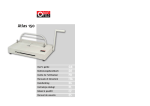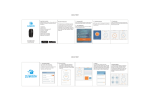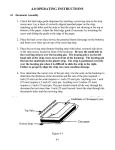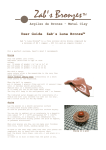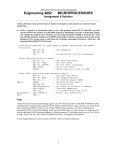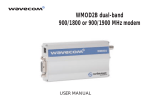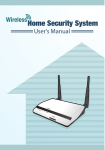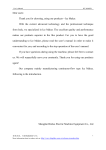Download GB Atlas 190 - Vector International
Transcript
Atlas 190 • User’s guide Atlas 190 GB User’s guide GB Contents: 16 METALBIND SYSTEM 56 BINDING WITH METALBIND 26 DESCRIPTION 66 DE-BINDING WITH METALBIND 36 HEALTH & SAFETY 76 C-BIND SYSTEM 46 PREPARATION TO WORK 86 TECHNICAL DATA 1 METALBIND SYSTEM Atlas 190 was designed to use channels and covers from the METALBIND system. The covers and the documents are clamped together from the outside by a Metalbind channel. Covers are larger and protect the documents and edges from damage, channels only touched by the covers plus making them secure and in their original condition. Metalbind is the strongest binding method. A special feature off the Atlas 190 is that it can also bind and de-bind covers from the C-Bind system. Metalbind 1 3 4 2 5 6 1 - The back wall of the channel is bent in to hold covers and pages. 2 - The channel is powder coated and covered with an embossed material. 3 - The special shaped Metalbind channel gives a perfect front look of your bound document. 4 - Pages are not touched or harmed by the channel they are protected by the covers. 5 - The front view of the cover is never misshaped or deformed. 6 - The special protrusions at each end help to centre the covers and documents in the channel and stops them moving before binding. GB Atlas 190 • User’s guide 2 DESCRIPTION 4 10 5 11 1 4 3 2 6 7 7 8 8b 8 3 7 1 -bind and de-binding handle 2 -clamp lever 3 -binding slot 4 -de-binding hooks 5 - de-binding wedge (Metalbind) 6 -channel width selecting tool 7 - front bar of the COVERguide system 8 -back bar of the COVERguide system with ruler 9 -fixed side stop 10 -adjustable side stop 11 -extended back support 9 10 3 HEALTH & SAFETY • Before operating the equipment read the Health & Safety precautions, manufacturers recommendations and the operation/user manual • The operation/user manual should be easily available at any time for the operator • The equipment must be kept away and out of reach of children • Equipment must be protected against dust and damp and should be positioned on a strong and sturdy flat surface • While binding, do not put fingers into the binding slot • Be careful when moving the equipment it is very heavy • Pay attention the de-binding wedge has sharp edges • The machine must not be used for any other purposes other than those indicated in the operating/user manual • It is necessary to check and supervise if the equipment is being used and operated correctly, before reporting any malfunctions or problems to the service department or dealer • Equipment must not be located outside or operated in temperatures under 8˚C / 46.4˚F and must be operated in accordance with the general Health & Safety rules failure to do so could cancel the guarantee • Repairs must be carried out by authorized staff, during the guarantee period, failure to do so could cancel the guarantee 4 PREPARATION TO WORK After taking the device out of the packing box, start assembling the equipment, attach the extended back support (11) on to the lower back support, to the pre drilled holes with the Allen key and screws supplied, now fit the bind & de-binding handle (1) with the bolt and Allen key supplied, in the hole in the side and tightened firmly. Now place the two plastic bars called (COVER GUIDE SYSTEM) (7 & 8) in the binding slot (8) with the ruler at the back of the slot, and the second bar (7) with magnets at the front (see diagram on the opposite page) The cover guide system has been specially designed to help you insert the covers and documents into the channel easily and centre covers and documents when using smaller channels. It is very important that the cover guide system is fitted correctly in the binding slot (3) the sloped edges of the bars should be facing each other in the binding slot please check by looking at the diagram. (see diagram on the opposite page). The equipment is now ready for work. 5 BINDING WITH METALBIND 1. Use channel width selecting tool (6) or table below to choose size of channel. Size of channel H/p/H H/p/T S/p/S O/p/O 5 7 10 - 31 32 - 60 10 - 33 34 - 63 10 - 34 35 - 63 10 - 38 39 - 67 10 13 16 61 - 89 90 - 118 119 - 148 64 - 92 93 - 121 122 - 150 64 - 92 93 - 121 122 -150 68 - 97 98 - 126 127 - 155 20 149-186 151 - 189 151 - 190 156 - 190 H = hard cover. p = pages. T = transparent cover. S = soft cover. O = no cover. Example: H/p/H =(H) hard cover/ (p)pages / (H) hard cover GB Atlas 190 • User’s guide 7 8 B Important! 7 - front edge guide for binding jaw The thickness of the documentation 8 - back guide with ruler A - channel B - binding jaw A to be bound must be at least 1,8 mm (with the cover). If the documentation is thinner, it is necessary to use the filling strips called O.filling Sticky, available from OPUS o make document thick enough to bind. 2. Make sure the binding bars also called cover guide system are correctly inserted into the binding slot (3) (see PREPARATION TO WORK and diagram above). 3. Pull up the bind and de-binding handle (1) to the open position, vertical. 4. Move the clamp lever (2) completely to the left. 5. Put the channel into the binding slot (3) between the bars (7 and 8) and insure that the channel is tight against the side stop (9) and the front of the channel is against the binding bar (8) see diagram above. When using smaller channels than A4 fit the adjustable side stop (10). Centre the smaller channel by using the ruler on the back bar in the slot and tighten the side stop (10)and do as in point 5 above. 6. Close the clamp lever (2) to the right until you can feel resistant’s on the lever. 7. Take the pile of documents insure they are even, put it between the covers, check the pages are centred in relation to the edges of covers. 8. Take the documents and covers and push carefully into the channel between the protrusions in the binding slot. NOTE that 5 mm O.CHANNELS and all O.SIMPLE CHANNELS do not have protrusions. Note! Make sure the back cover is facing you. 9. Push down firmly on the bind & de-binding handle (1) holding the covers and documents vertical till you feel the handle will go no further. 10. Now pull up the bind & de-binding handle (1) to the open position, vertical. Move the clamp lever (2) to the left completely to take out the bound documents. 11. If the documents are not clamped together firm enough, repeat the process 9 and 10. above again. 12. You may remove binded documentation. 1 Important! Be sure the back cover faces you. back cover 2 6 DE-BINDING WITH METALBIND ba co ck ve r 1. Lift the binding handle(1) up to the open position. 2. If fitted remove adjustable stop. 3. Ensure the clamp lever(2) is completely to the left,open. 4. Put the bound document flat on the equipment face down, back cover up. 5. Push the bound document, channel against the back support,firmly. 6. Open the bound document 5 to 6 pages from the back cover. De-binding 1 2 7 C-BIND SYSTEM 7. Fit the right end of the wedge (5) blade edge towards the channel, in the right hook (4) then place the left end of the wedge into the left hook (4). 8.Move the clamp lever (2) to the right till you feel some resistance, holding the lever. 9.Push down the binding handle (1) carefully, holding the clamp lever (2) at the same time, move the handle (1) up and down at the same time move the clamp lever (2) to the right carefully until the pages are just loose enough to come out of the channel. 10.Lift the handle (1) up, release clamp lever (2) and remove the document together with the wedge, then take the wedge out of the document carefully. 11.Make the planned changes to the document and re-bind. The cover may be re-used (a maximum of three times). Accessories for binding, measuring, de-binding covers of the C-Bind system. • Channel width selecting tool (6) • O.CB Insert for Atlas 190. for binding C-Bind covers, two part kit for all covers (dig.1) • O.CB Debinding tool for Atlas 190 - de-binding wedge (dig.2) and AA cover de-binding jig tool (dig.3) dig. 1 dig. 2 dig. 3 Atlas 190 • User’s guide GB 1. Using the channel width selecting tool (6), measure the thickness of the documents without the cover or choose the appropriate cover from the chart below. Sheet binding chart for the C-Bind system. Measure the thickness of the sheets to be bound, without covers. Select appropriate cover using the chart above. Then use the same binding procedure as Metalbind (see chapter 5). Channel size Inumber of sheet AA soft cover 15-40 hard cover 20-40 A 41-90 B 91-120 C 121-145 D 146-185 2. Documents to bind must have a minimum thickness of 1.8 mm, thinner must be bound using a filler strip called O.Filling Sticky from OPUS, these increase the thickness for binding. Before binding C-BIND covers remove the Metalbind binding bar (8) with ruler and insert the O.CB Insert for Atlas 190 binding bar, see (dig.1). 3. To de-bind C-BIND cover use O.CB de-binding wedge for Atlas 190 (Dig.2). Important! The AA cover de-binding jig tool included in the (O.CB Debinding Tool for Atlas 190) should be fitted on the spine edge of AA cover before debinding. 4. Follow the same binding and de-binding methods as in Metalbind, chapters 5 and 6. While binding or de-binding with C-Bind System, front or back of cover may face you. 8 TECHNICAL DATA • Binds and de-binds up to 190 sheets* = 380 pages ** • Dimensions: H-180 x W-435 x D-320 mm • Net weight: 16.1 kg • Gross weight: 18.5 kg * Tested on 80 g/m2 paper ** Printed each side








